Chapter 1 – Allegro
The First Fleet’s extraordinary cargo
A piano did undoubtedly come out to Australia on the First Fleet. The evidence is in the first fleet journals, but no one knows now which make or model of piano, other than to say it was a “square piano”.
It might have been a Longman & Broderip pianoforte, the one owned by Brian Barrow, and pictured to the right. It has a number stamped on it – 604, which means it was made about 1785-17861.
It might have been a Broadwood piano2 probably like the one below the Longman & Broderip piano. It was made in 1784. It is not the one bought by Mr Worgan in 1783. That seems to have been lost. There is another piano that claims to have the status of “First Fleet Piano”, donated to the Western Australian Academy of Performing Arts by Stewart Symonds. Geoffrey Lancaster, a professor at that academy is the proponent of the Beck piano3, pictured below the Broadwood piano. To recap, we do not know the make and model of square piano forte that Surgeon George Worgan took with him on the Sirius.
Surgeon George Boucher Worgan (1757-1838), travelled to Botany Bay on the Sirius with Captain Arthur Phillip. Another surgeon, Arthur Bowes-Smyth, who was on another of the first fleet ships, the Lady Penrhyn, kept a journal4 that tells us when the ships were all moored at Rio de Janeiro, some of the officers were invited to dine with Mr Worgan and to hear him play the piano.
Whilst the Arthur Bowes-Smyth journal describes George Worgan as seeming to be “a very sensible good kind of man”, and twice he mentions the piano, there is no physical description of the instrument, or whether it sounds good or not. Nevertheless, there seems to be a consensus that George Worgan’s piano was a square piano with five octaves, principally because that was the only sort of piano commonly available in London at the time. The relevant entries in Arthur Bowes-Smyth journal are shown below.
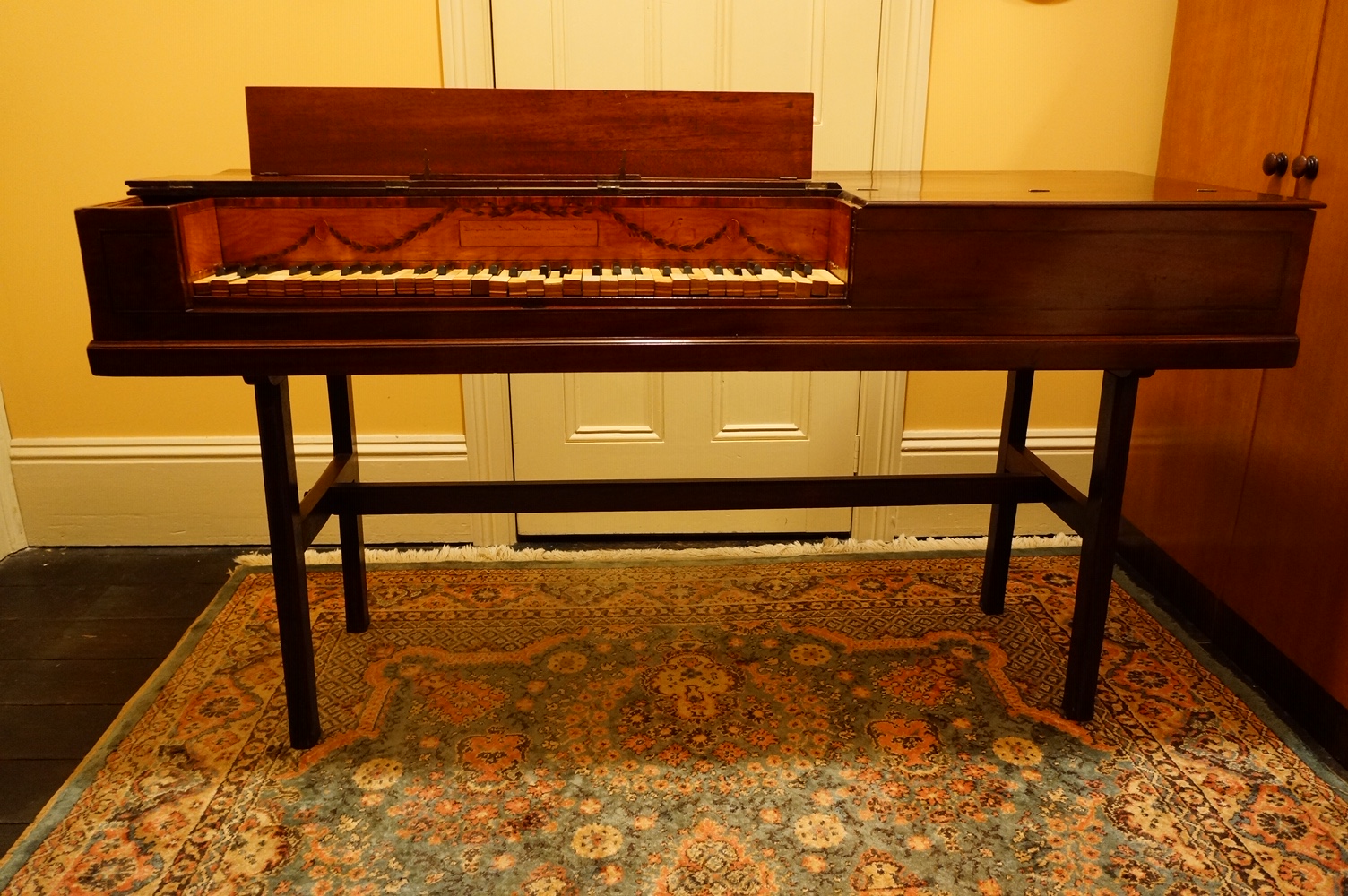
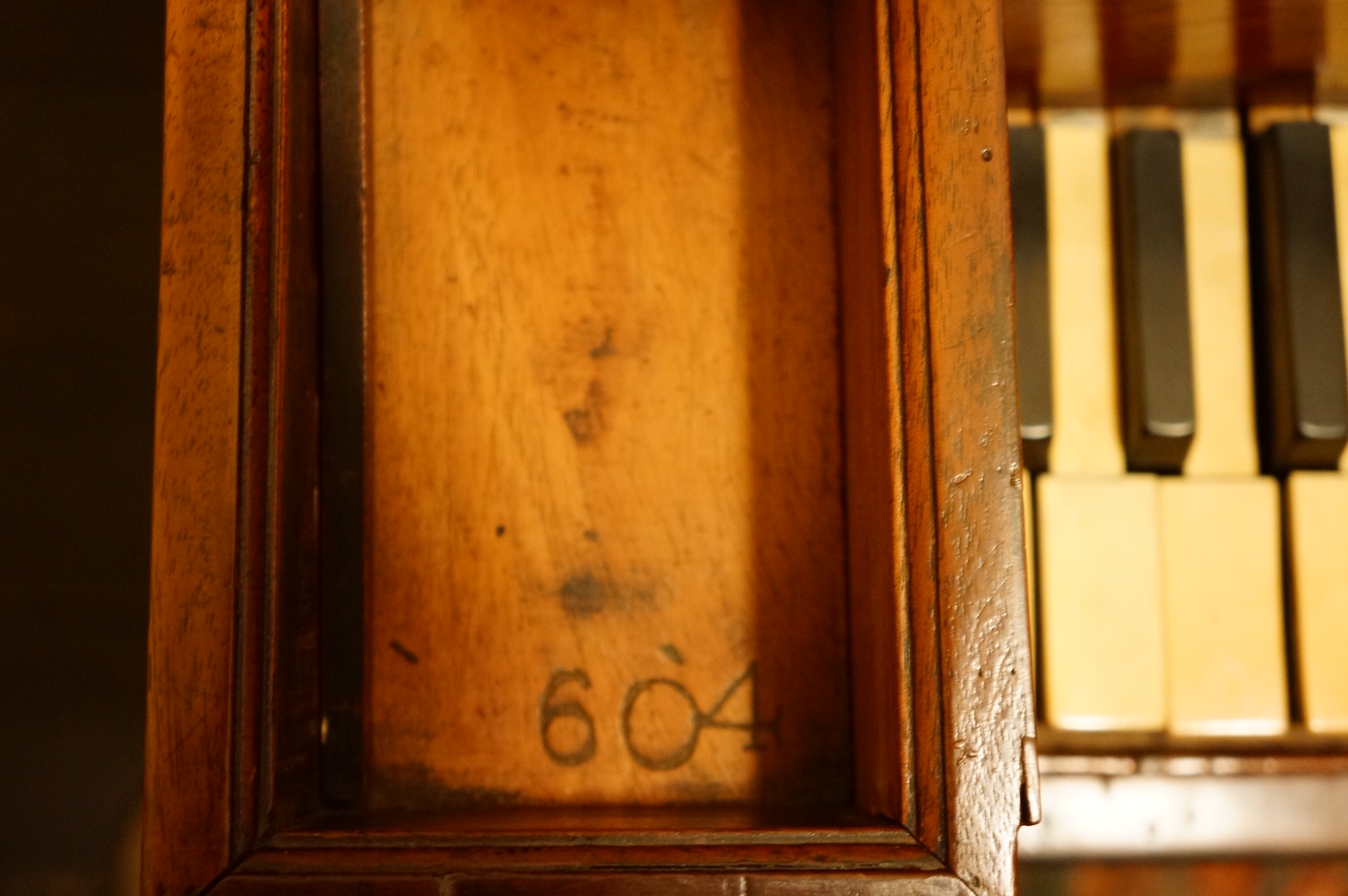

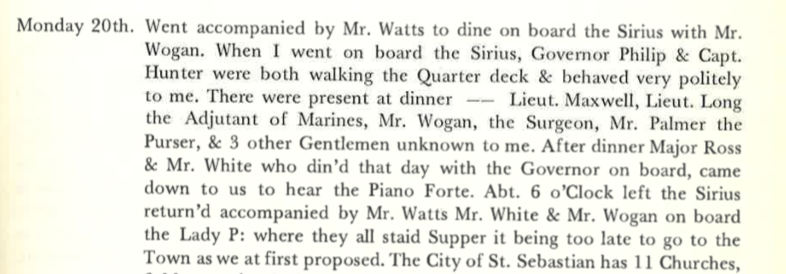

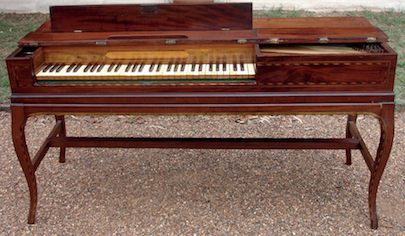
Seeing double
As would also happen with Handel’s harpsichord, JC Bach’s piano, and numerous religious relics, after 230 years, instead of there being ONE first fleet piano that is celebrated as the instrument that entertained the little settlement at Port Jackson, there are TWO such pianos!
To be “fair and square”, it can be estimated that there are really FOUR possibilities for the piano of the first fleet:
* A Broadwood square piano purchased on 10 April 1783 by Mr Worgan5;
* A 1785-6 Longman & Broderip square piano in a private collection belonging to Brian Barrow in Sydney;
* A 1780/1786 Beck square piano, which is in the collection of the Western Australian Academy of Performing Arts. The piano was donated by Stewart Symonds and its proponent is Professor Geoffrey Lancaster; and
* Another square piano as yet not identified.
The 1783 Broadwood piano so far has not surfaced, and perhaps it is no longer in existence. There is no information to confirm it was actually George Worgan who bought the piano. It could equally have been his brother Richard Worgan (1759-1840). The records in both the Beck and the Longman & Broderip companies have been lost. We cannot know if the piano bought by Mr Worgan from the Broadwood company was the only piano of that sort purchased by the Worgan family – a musical family – between 1781 and 1787. Until we know for sure what make and model of pianoforte that was brought to Australia in 1788, we have to be mindful of the possibility it could have been any one of a number of different pianos. By 1788, thousands of square pianos had been manufactured and sold by many different companies.
I can only expand on the pianos that are known of, so at this point, I need to declare my interest. The Longman & Broderip piano is owned by one of my many fourth cousins. We share great great great grandparents. Brian Barrow is a retired antique restorer, and has a good working knowledge of antiques. Needless to say, he has an extensive knowledge of antique pianos, and in particular, the Longman & Broderip piano in his possession. The Beck piano is commended to us by Professor Geoffrey Lancaster, an Australian academic, classical pianist and conductor. I would describe him as a highly acclaimed musician. Having heard some of his performances, I definitely agree with the description of him as being “at the forefront of historically-informed performance practice6. He is also very knowledgeable on antique pianos.
What is a “square piano?”
Square pianos are sometimes called “table pianos” because when the lid covering the keys is closed they look like a table, or as an alternative explanation, the piano (without legs) could be placed on a table to play. These pianos are quite small – about 150 cm x 60 cm. They are also much more portable than heavy steel framed pianos of the 20th and 21st century. Square pianos started appearing in London in the 1760s, and soon became a popular and most sought after household musical instrument for family entertainment use. Before 1780 in London the name John Zumpe was well known as a manufacturer of pianos. The original square pianos had just five octaves – this is not so limiting, because Mozart composed all his piano music on five octaves, and we enjoy listening to it to this day, never noticing the lack of very high or very low notes. Harpsichords of the day also had just five octaves. The following website provides more information about square pianos generally:
https://www.squarepianos.com/square.html
Another very informative website is: http://www.friendsofsquarepianos.co.uk
Plain or pretty legs?
Note the “curly” legs of the Beck piano – these are unusual and are technically known as “hinged cabriole legs”. The other two pianos shown have the standard trestle legs. The Beck also has elaborate Tunbridge-ware marquetry, i.e., inlaid work made from small pieces of coloured wood. The Beck piano can be played. If it was the one bought in 1973 by antiques dealer Bill Bradshaw, it seems it was playable then. I will come to that later. The Longman & Broderip piano, sadly, needs to have extensive restoration, and cannot be played at present.
In chapter 13 of his book7 Geoffrey Lancaster goes out on a limb by mentioning many times “George Worgan’s Beck piano”. There is no proof that George Worgan’s piano was made by Beck.
The reason for Lancaster’s use of this phrase is given in chapter 1 of “The First Fleet Piano”, where Lancaster states:
With the importance of historical context in mind, however, and when placed within the framework of evidence based on hearsay, the unique hinged cabriole legs and campaign-furniture-inspired stand of the 1780/86? Frederick Beck square piano represent the strongest evidence supporting speculation that the instrument was brought to Botany Bay by George Bouchier Worgan in 1788. The author favours this speculation.8.
So Lancaster rejects hearsay, preferring speculation about the piano legs.
What is “Campaign Furniture?”
Quite a few examples of “Campaign Furniture” are displayed in antique shows and auctions in the UK. “Items nearly always have military connections, and were intended to give senior officers the best possible standard of comfort. They are invariably mahogany, robustly constructed, and often ‘brass-bound’ with reinforced corners. There would be brass handles that folded flush, so that they would not get knocked in transit. In all my experience, pieces were NEVER veneered or in any way decorative, apart from the elegance of the mahogany and brass. I have never seen a piano or any other ‘leisure’ item made in this way. True, legs or stands (if any) would usually be arranged to fold, but would be plain and robust”.9
The utility or otherwise of “hinged cabriole legs”
The hinged cabriole legs are certainly extremely rare10. That it could be assumed that George Worgan could have afforded the extra expense and time required to make such legs for his piano is a bit mystifying. In 1784, a plain square piano cost more than a year’s income for a teacher, or one quarter the income of a surgeon11. That the Beck piano (promoted as the First Fleet piano by Geoffrey Lancaster) shows remarkably little damage for having been knocked around on a sailing ship, battered by wind and rain in the fledgling colony, not to mention surviving the numerous serious floods in Windsor NSW, is a real mystery! (more later). The alleged necessity of “hinged cabriole legs” for a piano to be transported on the First Fleet is highly questionable.
Regarding pianos specifically designed for travel, a rare example has been restored by David Hackett. He said, “There were also a few ‘travelling pianos’ (he has restored one, made by Trute, see picture to the right) but these have civilian connotations (rich ladies) and are usually smaller than normal. Many have no legs, and were designed to be put on a table (e.g. the Verel now in the Carolina Music Museum) but some, like the Trute, have folding legs. That one originally had a drawer at the right, hence the lopsided legs, which folded inwards”.12
Many square pianos had the trestle legs of the Longman & Broderip or the Broadwood pianos pictured above. All piano stands are bolted together and come to pieces for easy carriage. The hinged cabriole legs may or may not have provided extra stability on the a sea voyage (who would be trying to play a piano then, anyway?). The normal trestle stand such as on the Longman & Broderip piano shown above was quite stable also. It seems unlikely that George Worgan would really have tried to play the piano on the high seas, and no record of such has been found. On a ship, a piano like all the other furniture not firmly held down, would slip and slide around. Not all square pianos of the time had trestle stands, but it seems fair to say that the limited space on board the Sirius would have dictated that the piano be as compact as possible. “Hinged cabriole legs” are a more elegant design (but perhaps less compact than the basic trestle stand of the Longman & Broderip piano). Nevertheless, both contenders for being “The First Fleet Piano” have stands that can be collapsed down and compacted, thus making them suitable for storage and/or transport. Lancaster really does not explain satisfactorily why folding cabriole legs are a crucial part of the first fleet piano, and why the type of collapsible legs has any bearing on it being more or less suitable for transport.
See chapters 2, 3 and 4 for more!
This article will be updated when more information comes to light.
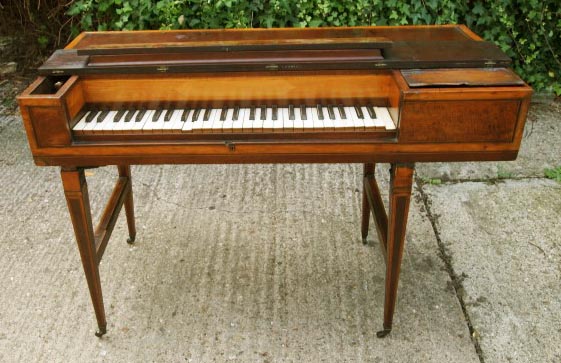
- David Hackett, Personal communication, 15 September 2018
- Wikipedia, John Broadwood & Sons, https://en.wikipedia.org, accessed 20 September 2018
- Geoffrey Lancaster, The First Fleet Piano: A Musician’s View, ANU Press 2015, volume 1, page 91.
- Smyth, Arthur Bowes, The Journal of Arthur Bowes Smyth: Surgeon, Lady Penrhyn 1787-1789, Fidlon, Paul G & Ryan RJ, ed, Australian Documents Library, Sydney, 1979.
- Geoffrey Lancaster, op. cit., page 260. He cites the Broadwood records.
- Western Australian Academy of Performing Arts, Professor Geoffrey Lancaster AM, (2011) https://www.waapa.ecu.edu.au/about/our-staff/profiles/music-jazz-classical-contemporary-composition-and-music-technology/professor-geoffrey-lancaster-am, accessed 20 September 2018.
- Geoffrey Lancaster, op. cit., volume 1, page 617
- ibid, at page 17
- David Hackett, personal communication 15 April 2019
- David Hackett, Personal communication, 30 September 2018
- David Hackett, Personal communication 30 September 2018
- Davide Hackett, personal communication 15 April 2019.


